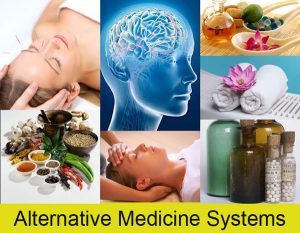by: Kevin O. Hunking

Introduction
As we look at the field of energy healing we need to recognize that it is a subset of a much larger area of inquiry known as Alternative Medicine. In this article I will be discussing the types of Alternative Medicine, as well as taking a quick look at some of the most popular forms of the practice. While it is my opinion that energy healing is very effective on its own, many of the other forms of Alternative Medicine can be combined with energy healing to create a more complete and balanced experience for both the practitioner and the client.
First off we will begin by defining what Alternative Medicine is versus what is called “Complimentary Medicine”:
Alternative medicine practices are used instead of traditional medical treatments and is distinct from complementary medicine which is meant to accompany, not replace, traditional medical practices. Alternative Medical practices are generally not recognized by doctors and researchers as conventional medical approaches.
Alternative Medicine is any practice that has similar healing effects to medicine, but does not originate from evidence gathered using the “scientific method” generally accepted within their tight-knit community.
The combined fields of complementary and alternative medicine are commonly known as CAM.
CAM has been growing in popularity recently. Nearly 40 percent of adults report using health care approaches developed outside of mainstream Western, or conventional, medicine. Doctors are embracing CAM therapies, too, often combining them with mainstream medical therapies, spawning the term “integrative medicine.”
I personally have found integrative medicine to be very gratifying as it shows an ever growing willingness on the part of the scientific community to step outside of their previously tight little “Jerry Coyne boxes” and recognize that there is so much more to learn from what was previously labeled as “woo-woo”. We have been seeing this growth more and more as scientists become increasingly open minded and less willing to blindly follow the dictates of a handful of self-serving power mongers. But I digress…
For the purposes of this article I am going to quickly explore the six primary disciplines that are most commonly seen in the field of Alternative Medicine. These are Acupuncture, Ayurvedic Medicine, Homeopathy, Naturopathic Medicine, Herbal Medicine and Traditional Chinese Medicine. This list is by no means exhaustive and I urge readers to explore other lesser known programs as well.
that are most commonly seen in the field of Alternative Medicine. These are Acupuncture, Ayurvedic Medicine, Homeopathy, Naturopathic Medicine, Herbal Medicine and Traditional Chinese Medicine. This list is by no means exhaustive and I urge readers to explore other lesser known programs as well.
Acupuncture
Acupuncture originated in China and can be traced back at least 2,500 years. Acupuncture is based on the premise that there are patterns of “Qi” energy flow moving through the body that are essential for health. Disruptions of this movement are believed to be responsible for many ailments, including disease. Acupuncture corrects these “imbalances of flow” at identifiable points close to the skin. The practice of acupuncture began with the discovery how the stimulation of these specific areas on the skin (called acupuncture points or acupoints) affected the functioning of certain organs of the body. It progressed into a system of medicine that restores and maintains health by the insertion of fine needles into the acupoints just below the surface of the skin. These points are in very specific locations and lie on channels of energy called meridians. The extreme thinness of the needles used ensures that little or no discomfort will be experienced during the treatment. This process stimulates the movement of Qi energy within the body, allowing natural healing to take place restoring the client’shealth.
How Does Acupuncture Work?
As mentioned, it is believed that there is a vital energy ‘Qi’ (pronounced ‘Chee’) which flows in meridians throughout the human body. The Chinese have identified 20 meridians in the human body providing a basic energy map for all people. Each of the major organs is associated with its own meridian. Through a network of meridians the internal organs are connected to certain areas and parts of the body including the muscles, bones, joints, and also other organs.
When healthy a person’s Qi energy flows smoothly through the meridians to nourish the organs and tissues. If a blockage occurs in one of the meridians, the Qi is disrupted and does not flow properly. When the Qi doesn’t flow smoothly (or. Even worse, is forced to flow in the opposite direction) the body’s innate balance is disrupted and illness results.
Ayurvedic Medicine
Ayurveda means “the science of life”.” Ayurvedic medicine is a system that originated in northern India over 5,000 years ago primarily from the Vedic texts. It includes a system of herbalism, but also offers dietary regulation, yoga and other exercises, bodywork, detoxification, and psychological interventions.
According to the Ayurvada being “healthy” is more than the absence of disease – it is a radiant state of energy, which is achieved by moderation in food intake, sleep, sex and other activities of daily life. This is also complemented by various treatments including a wide variety of plant-based medicines.
One of the first goals of this treatment is to determine the client’s dosha, or unique energy that controls various activities of the body. Overall health is believed to be directly related to the balance of these life forces in relation with each other.
There are three such doshas that are recognized:
- Vata is the energy of movement (breathing, heartbeat, etc.). The dosha of Vata can indicate a pattern of “over activity” and can lead to depletion. People with the vata pattern are often described as being “Type A” within western culture and are typically thin, quick-minded, alert, active, flexible and creative. When out of balance they become prone to anxiety and nervousness.
- Pitta composes the energy of digestion and hormones; this pattern is one of focused, sometimes aggressive activity that, when unchecked, can create abnormal heat. Individuals dominated by this constitution are of middle build and warm bodies, sharp intelligence and wit.
- Kapha involves the energy of strength, immunity and growth. Imbalances can lead to accumulation and stagnation. People dominated by this dosha have well-developed bodies and muscular function. These individuals are often more tolerant and possess both strength and endurance, but when out of balance, they tend to become somewhat lethargic and possessive.
Ayurvedic treatment plans often focus on rebalancing these doshas, eliminating toxins, improving digestion and addressing lifestyle habits. Herbal and other formulations are often recommended, along with aromatherapy, various forms of massage, supervised fasting, yoga exercises, meditation and counseling.
Homeopathy
Homeopathy is a medical science developed by Dr. Samuel Hahnemann. It is based on the principle that “like cures like”. It assumes that any substance, which can produce symptoms in a healthy person, can cure similar symptoms in a person who is unhealthy. The concept is referred to as the “Law of Similars“, and was understood by Aristotle and Hippocrates and mentioned in ancient Hindu manuscripts.
After his first experiments in 1790, Hahnemann experimented with many different substances, learning what symptoms they would produce and therefore, what they would cure. By 1829, Hahnemann had become quite famous throughout Europe. He produced many amazing cures in some of the worst epidemics of the time. During a typhus epidemic in 1813, Hahnemann cured 179 of 180 cases. Survival rates in Homeopathic hospitals far surpassed those in conventional ones. Because of its success in healing without harm to the patient, homeopathy was soon practiced all over the world. The wealthiest families and the royalty of Europe were early patrons of homeopathy.
Naturopathic Medicine
Naturopathic medicine is a distinct system of primary care that emphasizes prevention and self-healing processes via the use of natural therapies. Naturopathic doctors combine centuries-old knowledge with a philosophy that “nature is the most effective healer”.
Naturopathic diagnosis focuses on identifying the overall causes of a disease. Therapies are supported by research drawn from peer-reviewed journals.
The therapeutic modalities used in naturopathic medicine include physical manipulation, clinical nutrition, botanical medicine, homeopathy and hydrotherapy. Naturopathic medicine integrates conventional, scientific and empirical methodology with the ancient laws of nature.
Naturopathic medical practice include six principles:
- “Do No Harm”
- The Healing Power of Nature
- Discover and Treat the Cause, Not Just the Effect
- Treat the Whole Person
- The Physician is a Teacher
- Prevention is the best “cure”
Naturopathic doctors attend a four-year naturopathic medical school and are clinically trained.
Most Naturopathic doctors provide primary care through office-based private practice. Some receive additional training in areas such as Midwifery, Acupuncture and Oriental Medicine. Naturopathic doctors cooperate with other medical professionals, referring patients to (and receiving patients from) conventional medical doctors, surgeons and other specialists when appropriate.
Oriental Medicine
Traditional Chinese medicine is an ancient medical system that takes a deep understanding of the laws and patterns of nature and applies them to the human body. It encompasses many different practices and is rooted in the ancient philosophy of Taoism.
The human body is regarded as an organic entity in which the various organs, tissues, and other parts have distinct functions but are all interdependent. In this view, health and disease relate to balance of the functions. Oriental medicine differs from western medicine in its methodology of diagnosing, which focuses on disturbances of qi (also found in Acupuncture). Diagnosis requires observing the patient closely utilizing all of the senses
Herbal Medicine
Herbal medicine, also known as herbalism, is a medical system based on the use of plants or plant extracts that are eaten or applied to the skin. Herbal medicine has been used by many different cultures throughout the world to treat illness and to assist bodily functions. While herbal medicine is not a licensed profession in the United States, herbal remedies may be recommended by healthcare practitioners of many different disciplines as a practical way to address a wide variety of medical conditions.
Herbal medicine blurs the line between foods and medicines. For example, it appears that the daily use of the spice turmeric in curry dishes is one reason elderly people in India have one of the lowest rates of Alzheimer’s disease in the world.

Excelent !!!! Thanks for the clarity used on the article.